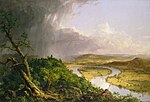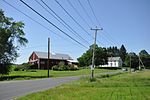Fort River
The Fort River is a river in Western Massachusetts and is a tributary of the Connecticut River and runs through the towns of, Amherst, Massachusetts, and ends in Hadley, Massachusetts.The Fort technically begins as Adams Brook which begins at a pond near Atkin's Reservoir in Shutesbury, Massachusetts (however the ponds aren't part of the reservoir), and flows south-west ward until it reaches the spot where Amythest Brook flows into it, where it becomes the "Fort River." Although it has no dams or man-made things on the river, some of the Fort's tributaries have reservoirs. The Fort River has a wide variety of wildlife due to it being the longest free-flowing tributary (having no dams or other man made changes made to the rivers shape or flow) of the Connecticut River. Because of this there is a lot of wildlife making it one of the 3 most diverse rivers in the state. Mussels, Eastern Pearlfish, Sea Lampreys, and American Eel's.
Excerpt from the Wikipedia article Fort River (License: CC BY-SA 3.0, Authors).Fort River
Middle Street,
Geographical coordinates (GPS) Address Nearby Places Show on map
Geographical coordinates (GPS)
| Latitude | Longitude |
|---|---|
| N 42.3261 ° | E -72.5843 ° |
Address
Middle Street 236
01035
Massachusetts, United States
Open on Google Maps






